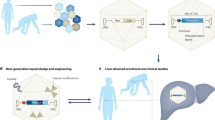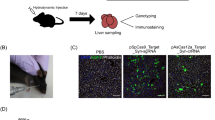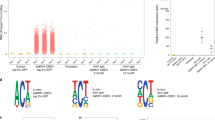Abstract
The ideal gene therapy is one that repairs the precise genetic defect without additional modification of the genome. Such a strategy has been developed for correcting single nucleotide mutations by using RNA/DNA oligonucleotides, or chimeraplasts. This approach for in situ repair is based on the delivery of exogenous DNA designed to mediate genomic base conversion, insertion, or deletion, thereby, correcting the genetic mutation. Using in vivo delivery systems to hepatocytes via the asialoglycoprotein receptor, we targeted rat liver DNA and successfully modified the genomic sequence by chimeraplasty. The changes in both the hepatic genes, and their associated phenotypes remained stable for 2 years. In addition, we also examined the potential to alter sequence defects in mitochondrial DNA. Therefore, we determined whether mitochondria possess the enzymatic machinery for chimeraplast-mediated DNA changes. Using an in vitro DNA repair assay of mutagenized plasmids and an Escherichia coli readout system, we showed that extracts from highly purified rat liver mitochondria have the essential enzymatic activity to mediate precise single-nucleotide changes at a frequency similar to liver nuclear extracts. Moreover, single-stranded oligonucleotides carrying a single nucleotide mismatch with the target sequence were capable of promoting gene conversion using either mitochondrial or nuclear extracts. Several approaches now exist for the precise repair of genetic mutations using either single-stranded or RNA/DNA chimeric oligonucleotides.
This is a preview of subscription content, access via your institution
Access options
Subscribe to this journal
Receive 12 print issues and online access
$259.00 per year
only $21.58 per issue
Buy this article
- Purchase on Springer Link
- Instant access to full article PDF
Prices may be subject to local taxes which are calculated during checkout




Similar content being viewed by others
References
Ferber D . Gene therapy: Safer and virus-free Science 2001 294: 1638–1642
Nishikawa M, Huang L . Nonviral vectors in the new millennium: delivery barriers in gene transfer Hum Gene Ther 2001 12: 861–870
Wu GY, Wu CH . Receptor-mediated gene delivery and expression in vivo J Biol Chem 1988 263: 14621–14624
Roy Chowdhury N et al. Fate of DNA targeted to the liver by asialoglycoprotein receptor-mediated endocytosis in vivo. Prolonged persistence in cytoplasmic vesicles after partial hepatectomy J Biol Chem 1993 268: 1265–11271
Findeis MA, Wu CH, Wu GY . Ligand-based carrier systems for delivery of DNA to hepatocytes Meths Enzymol 1994 247: 341–351
Kren BT et al. Oligonucleotide-mediated site-directed gene repair Meth Enzymol 2002 346: 14–31
Kotani H, Kmiec EB . Transcription activates RecA-promoted homologous pairing of nucleosomal DNA Mol Cell Biol 1994 14: 1949–1955
Kotani H, Kmiec EB . A role for RNA synthesis in homologous pairing events Mol Cell Biol 1994 14: 6097–6106
Kmiec EB . Targeted gene repair Gene Therapy 1999 6: 1–3
Gamper HB Jr. et al. A plausible mechanism for gene correction by chimeric oligonucleotides Biochemistry 2000 39: 5808–5816
Yoon K, Cole-Strauss A, Kmiec EB . Targeted gene correction of episomal DNA in mammalian cells mediated by a chimeric RNA.DNA oligonucleotide Proc Natl Acad Sci USA 1996 93: 2071–2076
Cole-Strauss A et al. Correction of the mutation responsible for sickle cell anemia by an RNA-DNA oligonucleotide Science 1996 273: 1386–1389
Kren BT et al. Targeted nucleotide exchange in the alkaline phosphatase gene of HuH-7 cells mediated by a chimeric RNA/DNA oligonucleotide Hepatology 1997 25: 1462–1468
Kren BT, Bandyopadhyay P, Steer CJ . In vivo site-directed mutagenesis of the factor IX gene by chimeric RNA/DNA oligonucleotides Nature Med 1998 4: 285–290
Bandyopadhyay P et al. Enhanced gene transfer into HuH-7 cells and primary rat hepatocytes using targeted liposomes and polyethylenimine BioTechniques 1998 25: 282–292
Bandyopadhyay P et al. Site-directed nucleotide exchange in genomic DNA of rat hepatocytes using RNA/DNA oligonucleotides. Targeted delivery of liposomal systems and lactosylated polyethylenimine to the asialoglycoprotein receptor J Biol Chem 1999 274: 10163–10172
Higgins GM, Anderson RM . Experimental pathology of the liver. I. Restoration of the liver of the white rat following partial surgical removal Arch Pathol 1931 12: 186–202
Higgins GM, Anderson RM . Experimental pathology of the liver. I. Restoration of the liver of the white rat following partial surgical removal Steer CJ et al. Liver-directed gene therapy. In: Arias IM et al (eds). The Liver: Biology and Pathobiology. 4th edn. Lippincott Williams and Wilkins: New York, 2001, pp 941–962
Kren BT et al. Correction of the UDP-glucuronosyltransferase gene defect in the Gunn rat model of Crigler-Najjar syndrome type I with a chimeric oligonucleotide Proc Natl Acad Sci USA 1999 96: 10349–10354
Iyanagi T, Watanabe T, Uchiyama Y . The 3-methylcholanthrene-inducible UDP-glucuronosyltransferase deficiency in the hyperbilirubinemic rat (Gunn rat) is caused by a -1 frameshift mutation J Biol Chem 1989 264: 21302–21307
Roy-Chowdhury J et al. Molecular basis for the lack of bilirubin-specific and 3-methylcholanthrene-inducible UDP-glucuronosyltransferase activities in Gunn rats. The two isoforms are encoded by distinct mRNA species that share an identical single base deletion J Biol Chem 1991 266: 18294–18298
Brown MD et al. Phylogenetic analysis of Leber's hereditary optic neuropathy mitochondrial DNA's indicates multiple independent occurrences of the common mutations Hum Mutat 1995 6: 311–325
Hanna MG, Nelson IP . Genetics and molecular pathogenesis of mitochondrial respiratory chain diseases Cell Mol Life Sci 1999 55: 691–706
Friedberg EC, Walker GC, Siede W . DNA Repair and Mutagenesis ASM Press 1995
Bogenhagen DF . Repair of mtDNA in vertebrates Am J Hum Genet 1999 64: 1276–1281
Kren BT et al. Gene Repair using RNA/DNA oligonucleotides Semin Liver Dis 1999 19: 93–104
Cole-Strauss A et al. Targeted gene repair directed by the chimeric RNA/DNA oligonucleotide in a mammalian cell-free extract Nucleic Acids Res 1999 27: 1323–1330
Rodrigues CM et al. Ursodeoxycholic acid may inhibit deoxycholic acid-induced apoptosis by modulating mitochondrial transmembrane potential and reactive oxygen species production Mol Med 1998 4: 165–178
Thyagarajan B, Padua RA, Campbell C . Mammalian mitochondria possess homologous DNA recombination activity J Biol Chem 1996 271: 27536–27543
Chen Z et al. Mitochondria isolated from liver contain the essential factors required for RNA/DNA oligonucleotide-targeted gene repair Biochem Biophys Res Commun 2001 285: 188–194
Thyagaraan B, Cruise JL, Campbell C . Elevated levels of homologous recombination activity in the regenerating rat liver Somatic Cell Mol Genet 1996 22: 31–39
Gamper HB et al. The DNA strand of chimeric RNA/DNA oligonucleotides can direct gene repair/conversion activity in mammalian and plant cell-free extracts Nucleic Acids Res 2000 28: 4332–4339
Igoucheva O, Alexeev V, Yoon K . Targeted gene correction by small single-stranded oligonucleotides in mammalian cells Gene Therapy 2001 8: 391–399
Igoucheva O et al. A sequence-specific gene correction by an RNA-DNA oligonucleotide in mammalian cells characterized by transfection and nuclear extract using a lacZ shuttle system Gene Therapy 1999 6: 1960–1971
Tagalakis AD et al. Gene correction of the apolipoprotein (Apo) E2 phenotype to wild-type ApoE3 by in situ chimeraplasty J Biol Chem 2001 276: 13226–13230
Liu L, Rice MC, Kmiec EB . In vivo gene repair of point and frameshift mutations directed by chimeric RNA/DNA oligonucleotides and modified single-stranded oligonucleotides Nucleic Acids Res 2001 29: 4238–4250
Acknowledgements
This work was funded in part by National Institutes of Health Grants P01 HD32652 to BTK, RO1 DK39137 to NRC, RO1 DK46057 to JRC, P01 HL65578 and P01 HL55552 to CJS, and ValiGen, Inc. to CJS.
Author information
Authors and Affiliations
Rights and permissions
About this article
Cite this article
Kren, B., Chen, Z., Felsheim, R. et al. Modification of hepatic genomic DNA using RNA/DNA oligonucleotides. Gene Ther 9, 686–690 (2002). https://doi.org/10.1038/sj.gt.3301762
Published:
Issue Date:
DOI: https://doi.org/10.1038/sj.gt.3301762
Keywords
This article is cited by
-
Gene Therapy of the Other Genome: The Challenges of Treating Mitochondrial DNA Defects
Pharmaceutical Research (2007)



